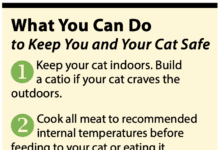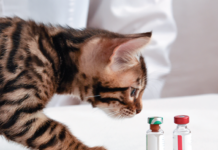There is no doubt that vaccines can and do save lives. The rabies vaccine is a perfect example.Rabies is a viral zoonotic disease that is routinely fatal once symptoms occur, even in people with extensive medical care. It is endemic in North America, meaning it exists throughout the continent.
Wildlife populations can spread this disease. As people move into suburbs and more wildlife habitat is destroyed, the odds of coming in close contact with animals such as bats, raccoons, foxes, and skunks that are carrying rabies increase. That means you and your pets are at a higher risk of contracting rabies and dying. By vaccinating pets against rabies, the risk to both people and pets is minimized.
Other feline vaccines prevent or minimize clinical illness from diseases that can be fatal, such as feline leukemia and distemper. Are there some risks? Yes, and studies have led to the development of core versus non-core vaccine recommendations so that your cat does not receive vaccines against diseases she is not at high risk of being exposed to. Vaccine risks for the general cat population are incredibly low, as explained in a recent Germs and Worms blog by Scott Weese, DVM, of the University of Guelph (Ontario, Canada).
Vaccine hesitancy is the catch phrase used for people who are reluctant to vaccinate their pets for numerous reasons. Some are reluctant to trust science in general, while others may have concerns about vaccine risks they have read about or have had their cats experience adverse reactions to vaccinations in the past.
It is important to note that vaccine development has advanced greatly. Vaccines use recombinant technology in many cases to reduce chances of a reaction and to minimize the chances of inducing illness after a vaccine.
The use of adjuvants, which are added to vaccines as immune-system stimulators, has been greatly reduced since concern was raised about the possibility of their contributing to adverse reactions, most notably vaccine-associated sarcomas.
A study from 2007 showed an overall vaccine reaction rate of 0.51% in cats. These reactions included things as minor as lethargy and as severe as anaphylactic shock. This study tracked cats for a month, so some long-term effects such as vaccine-associated sarcomas might not be detected. That rate is estimated at one case per 10,000 to 30,000 vaccinations according to the American Veterinary Medical Association (AVMA). Veterinarians now follow a set pattern of injection sites to track sarcomas and allow for easier treatment if they occur.
The best way to minimize vaccine risks is to carefully evaluate the need for each vaccine based upon your cat’s health, lifestyle. age, and vaccine history with your veterinarian and eliminate those that are not deemed necessary due to low likelihood of exposure to the microroganism that they are designed to protect against. In some cases, local regulations may require that certain vaccines be given to your cat, but this is the exception rather than the rule. When possible, spread vaccines out rather than giving all the vaccines at one visit. If your cat has a reaction, discuss future use of vaccines and/or titers with your veterinarian.
“If we had lower vaccination rates, we’d have fewer animals with vaccine reactions (that are almost always transient), but a lot more animals with severe and potentially fatal disease (which can have permanent long-term consequences), even if the animal survives,” says Dr. Weese. Lower vaccination rates would also increase human risk of zoonotic diseases such as rabies via transmission from your pets.




